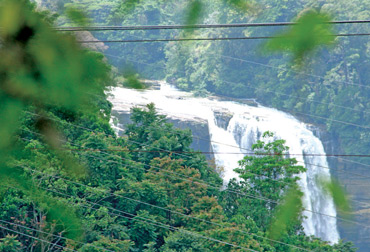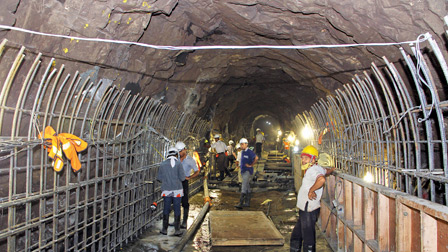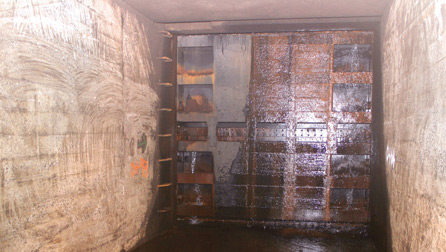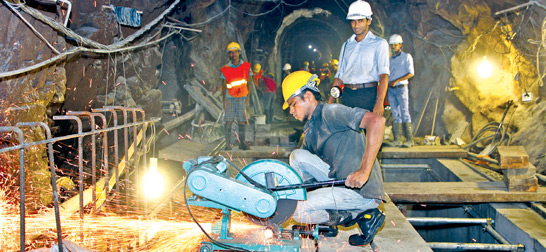|
Work to be completed soon:
Renovation work on New Laxapana under way
By Gamini Warushamana
After 40 years of uninterrupted service, the New Laxapana hydro power
station was stopped for a short break on January 20.
|

Engineers H. M. A. Herath and Erosh Fernando |
The contribution by this power plant to the national economy is huge
and during the past 40 years it has generated over 20 trillion watt
hours or 20,000 Gwh of electricity, and fed the national grid with the
cheap electricity, at a unit cost of about Rs.1.50 against a thermal
unit which costs over ten times that amount.
The Laxapana hydro power complex consists of five dams and five power
stations constructed across Kehelgamu Oya and Maskeliya Oya, branches of
the Kelani river.
Water level
These five hydro power stations that are in the wet zone generate
power almost throughout the year. The water level of the reservoirs
rarely declines but due to the prevailing drought the generation
capacity of the power stations has reduced and the CEB is servicing and
renovating the facilities.
Of the five hydro power stations in the Laxapana complex two are in
Kehelgamu Oya and three in Maskeli Oya. The Castlereagh reservoir is at
the top of the Kekelgamu Oya and is the main reservoir.
It feeds the 50 MW Wimalasurendra power plant which was commissioned
in 1958.
|

The Laxapana waterfall and cactchment area. |
The water which comes from the Wimalasurendra power plant is
collected in the Norton Pond reservoir and it feeds the old 53.5 MW
Laxapana power plant commissioned in 1950.
The Moussekelle reservoir is at the top of Maskeli Oya and it feeds
60 MW Canyon power plant commissioned in 1969.
The water passes to the Canyon pond and it feeds the 116MW New
Laxapana power plant commissioned in 1974. Water released at the New
Laxapana power plant is again collected at the Laxapana pond and it
feeds the 75 MW Polpitiya power plant commissioned in 1969.
The system has been designed to use the water continuously to
generate hydro power using the geographical advantages in the region.
The five power plants account for 338 MW or 28 percent of the total
hydro capacity of the CEB. Major renovation work in the 18,014-foot long
tunnel of the New Laxapana power plant is now under way.
According to the Chief Engineer of the Laxapana Generating Stations,
H.M.A. Herath this is the first major renovation in 40 years, after its
commissioning in 1974.
Significant loss
|

Concrete lining to close the cavityy |
"The water leak in the tunnel was first observed in 1978, four years
after commissioning and gradually the leak increased. In 1998 after
studies it was confirmed that 100 percent of the water was from a leak
in the tunnel and we estimated it as 230 litres per second. It was a
significant loss and the estimated financial loss as a result of reduced
power generation capacity was Rs.130 million a year," he said.
The civil engineer of the Laxapana Generating Stations, Erosh
Fernando said that although the loss was significant renovation was
difficult due to several reasons.
"First, the tunnel had to be shut down for inspection. But shutting
down the tunnel was risky because it could lead to the collapse of weak
rocks and take a long time to renovate," he said.
"According to engineering discipline this type of tunnel should be
renovated every 10-15 years. From 2002-2004 we attempted to renovate the
tunnel but as the demand for power was increasing and alternatives were
limited it was difficult to get approval to shut down the tunnel,"
Fernando said.
"We waited for an opportunity after the Norochcholai coal power plant
was commissioned but that too was not possible due to the frequent shut
down of the coal power plant. Today with the drought and decline in
water levels we got approval and found the fault and renovation is under
way," he said.
Weak rock layers
|

The tunner door at the Canyon Pond. |
Renovation work will be completed soon. After the tunnel was shut
down a cavity and 56 metres of weak rock layers were found in the tunnel
from where water was leaking.
A 3.2 metre diameter concrete structure of is being constructed to
close the cavity and cover the weak rock layers.
Civil construction work is handled by ST and CC under the supervision
of the CEB engineers and the renovation project is funded by the Dam
Safety and Water Resources Management Project (DSWMP).
DSWMP has also provided a foreign expert knowledgeable in underground
tunnels. The estimated cost of the renovation work is Rs.100 million and
Herath said that the expenditure can be earned within a year by
increased power generation.
Hydro power generation converts the potential energy of water in the
upper stream to kinetic energy and finally to electric energy. This is a
simple process but the civil engineering construction and investment is
huge.
In New Laxapana's long tunnel, various simple technologies have been
used to control the huge water flow. The surge shaft is used to reduce
water pressure in the tunnel when the turbines are closed suddenly.
Water pressure
|

Construction workers renovating the tunnel |
The surge shaft is similar to hummanaya or blowhole and when the
water to the turbines is shut down the water pressure in the tunnel is
released through the surge shaft. It is a vertical tunnel of over 300
feet. Rocks and hard material that come with the water are removed
through rock traps in the tunnel.
Rock traps are deep pits in the tunnel and there are three rock traps
in the New Laxapana tunnel. With soil erosion and deforestation in the
catchment areas, rock traps have to be cleaned more frequently. Sri
Lanka has now used almost all the thermal power potential in the country
and only mini and micro hydro projects are left. The country now needs
to maintain the sustainability of these mega hydro projects.
All the catchment areas of the reservoirs are under threat.
Deforestation, encroachment for residential or agriculture purposes is
taking place. Engineers said they face many difficulties in their bid to
conserve forest land belonging to the CEB in the catchment areas. |

